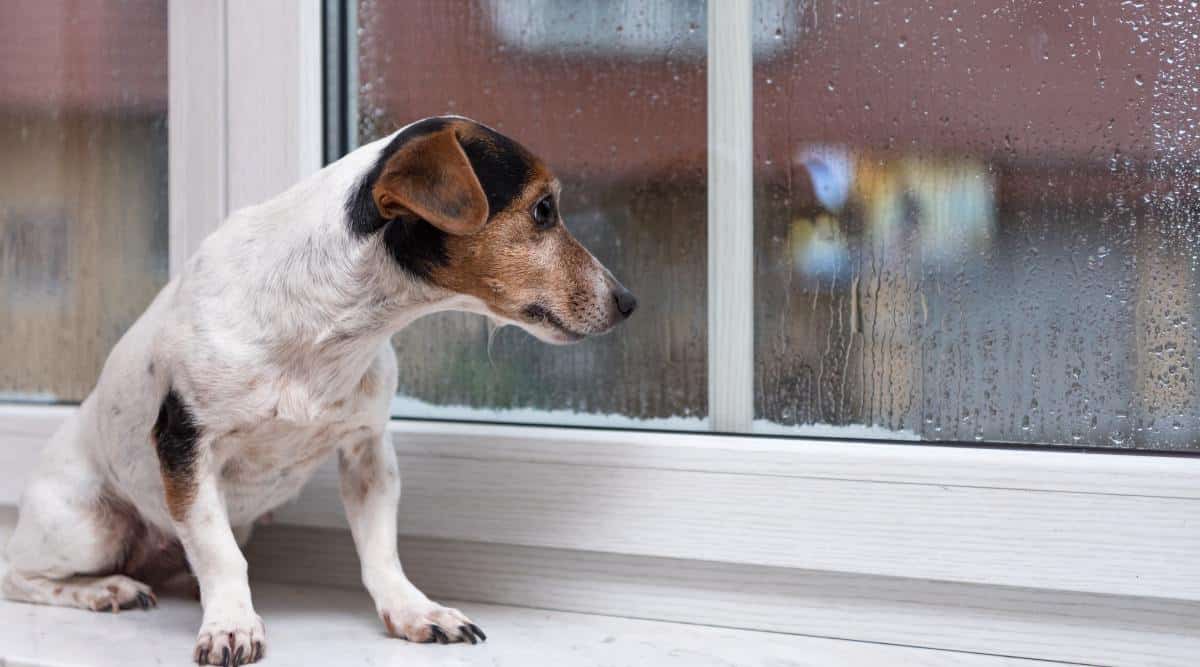When you purchase through links on our site, we may earn a commission. Here’s how it works.
My dog Daisy, a senior Pitbull-Labrador mix, has always struggled with travel anxiety. She’s calm and relaxed at home, but the moment she senses a car ride, her demeanor shifts, barking erupts, she spins in frantic circles, and her eyes fill with panic before we even leave the driveway.
Table of Contents
Last summer, we moved, which meant weeks of hotel stays, car rides, and constant changes in routine. For Daisy, it was overwhelming. I quickly realized that managing her stress wasn’t just about comfort but safety and well-being.
Travel anxiety in dogs is more common than many realize. Whether triggered by motion, new environments, or disrupted routines, it can make even a short trip impossible. But the proper preparation, tools, and understanding can make a world of difference.
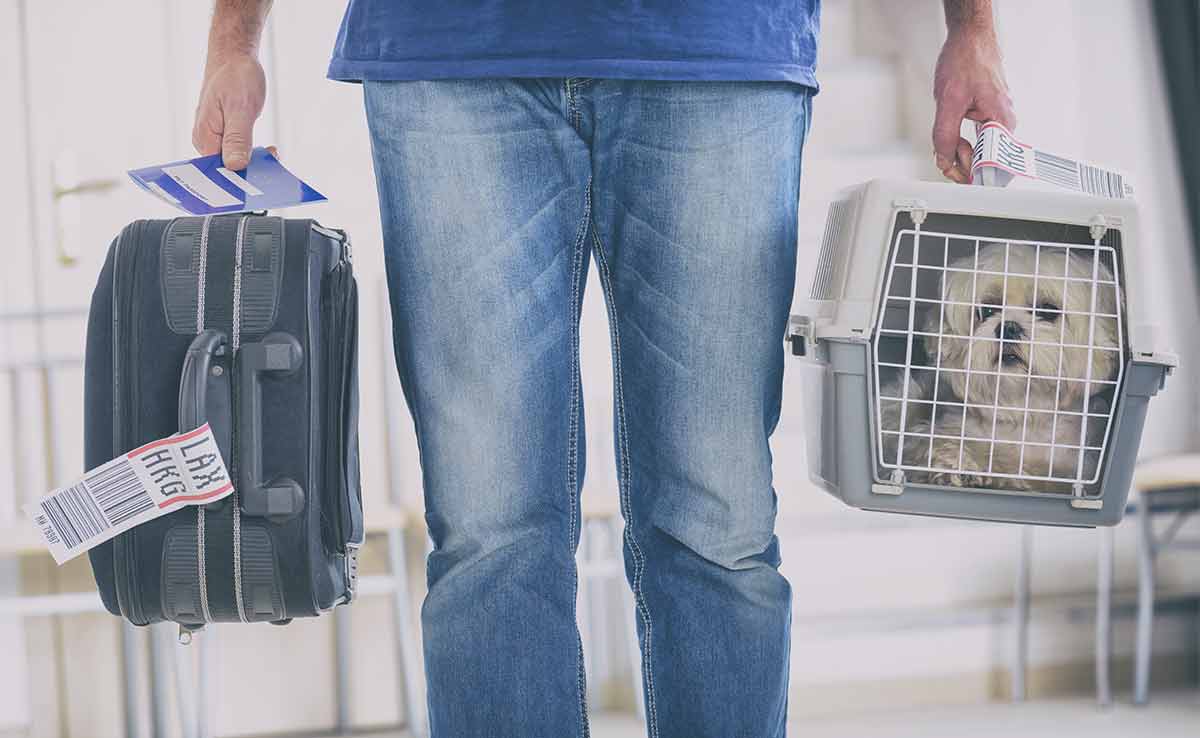
In this guide, you’ll learn:
- What triggers travel anxiety in dogs like Daisy
- How to recognize early signs of distress
- Calming strategies and tools recommended by vets
- Natural solutions like CBD and pheromone therapy
If travel has become a source of stress and anxiety for your dog, this guide will help you turn the experience into something manageable, even enjoyable.
A Firsthand Look at Managing Dog Travel Anxiety Across Europe
Before we dive into our top tips for easing travel anxiety in dogs, we wanted to share a story from one of our team members who spent over a year traveling across Europe with her dog, Bonkers.
From settling into homes in Germany and Spain to nine months living in a camper van, her experience highlights the emotional side of pet travel and what really helped her dog feel safe through all the transitions.

I spent a few incredible years living and traveling across Europe with my dog, Bonkers. For nine months each, we settled into permanent homes in both Germany and Spain, giving us the chance to really soak up the local culture and pace of life.
After that, we hit the road in a camper van for another nine months, exploring Western Europe on the move. While Bonkers is usually a pretty chilled-out dog, he always got a bit anxious whenever we started packing up to move on.
Sticking to a familiar routine helped a bit, but what made the biggest difference was giving him lots of one-on-one time. That personal connection really helped ease his travel nerves and keep him feeling secure, no matter where we were headed next.
– Emma Braby, Travelling Dog Mom & Canine Journal Writer
What Causes Travel Anxiety in Dogs? 5 Triggers
Dogs can be overwhelmed by a mix of triggers during travel. Understanding these causes is key to preventing and managing anxiety.
1. Sensory Overload
Vehicles are full of unfamiliar stimuli: moving scenery, strange smells, engine noise, and constant motion. This flood of sensory input—especially when visual and balance cues don’t align—can overload a dog’s nervous system and lead to distress.
2. Motion Sickness
When a dog’s inner ear senses motion but their vision remains fixed (as it might in a car), the mismatch can trigger nausea. Puppies and young dogs are particularly prone, as their balance systems may not be fully developed. Repeated experiences of nausea can cause dogs to associate the car with discomfort, reinforcing their anxiety.
3. Past Traumatic Experiences
Dogs who have only experienced travel in stressful contexts, like vet visits or rehoming—often develop a negative association with vehicles. A single traumatic car ride can create a long-lasting fear response, especially if it’s not followed by positive reinforcement or desensitization.
4. Lack of Training or Conditioning
Like many behaviors, riding calmly in a car is a learned skill. Dogs that aren’t gradually introduced to car travel in a controlled, positive way are more likely to develop anxiety. This is especially true for dogs that weren’t exposed to new environments during critical early socialization periods.
5. Limited Socialization or Disrupted Routine
Older dogs or those who thrive on routine may become anxious when their familiar environment changes. Travel often disrupts feeding times, sleep, and comfort zones, all of which can contribute to stress.
Breaking Down Travel Anxiety by Type
Not all travel is created equal, especially from your dog’s point of view. A quick car ride to the vet can trigger one kind of stress, while a flight or a noisy train trip brings an entirely different set of challenges. Understanding how anxiety shows up across various forms of travel is key to preparing your dog for a calm and safe experience.
Car Anxiety
For many dogs, car rides are a frequent source of stress. Whether it’s motion sickness, loud noises, or the unfamiliar sensation of movement, the experience can be both disorienting and frightening, particularly for dogs that haven’t been conditioned to travel.
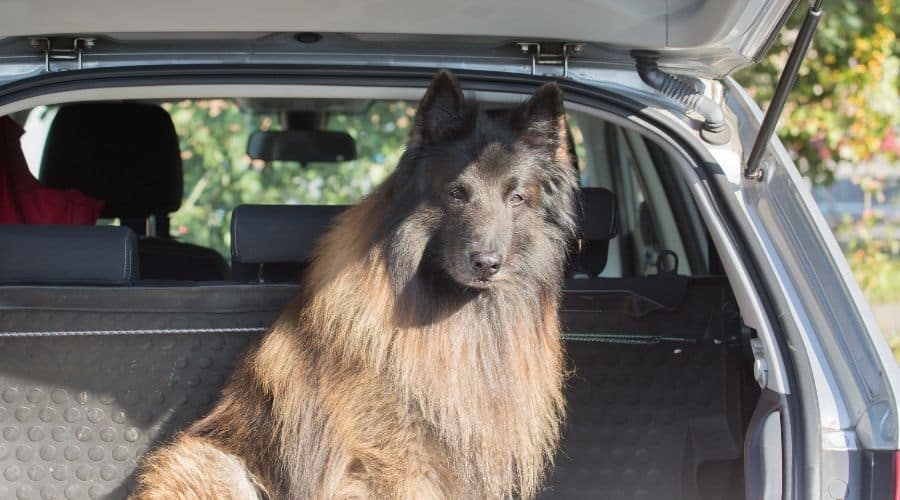
- Common Triggers – Dogs may experience nausea, confusion from the passing scenery, or insecurity if they’re not properly restrained. Temperature fluctuations and the sound of honking or sudden braking can also heighten their anxiety.
- How to Prepare – Start with short, positive car trips to help your dog acclimate. Avoid feeding your dog right before travel. Use calming tools such as pheromone sprays or include a familiar-smelling blanket to make the space more reassuring.
- On the Day of Travel – Ensure your dog is safely secured with a crash-tested harness or inside a well-ventilated crate. Keep the vehicle cool and quiet. Bring along essentials like a toy, water, and window shades to minimize glare.
- Legal Considerations – Some states, such as New Jersey, require pets to be restrained in moving vehicles. If you’re traveling across state lines, research relevant laws to stay compliant and avoid fines.
Plane Anxiety
Air travel can be especially difficult for dogs. Whether they fly in the cabin or cargo hold, the unfamiliar sounds, spaces, and separation from their owner can be overwhelming.
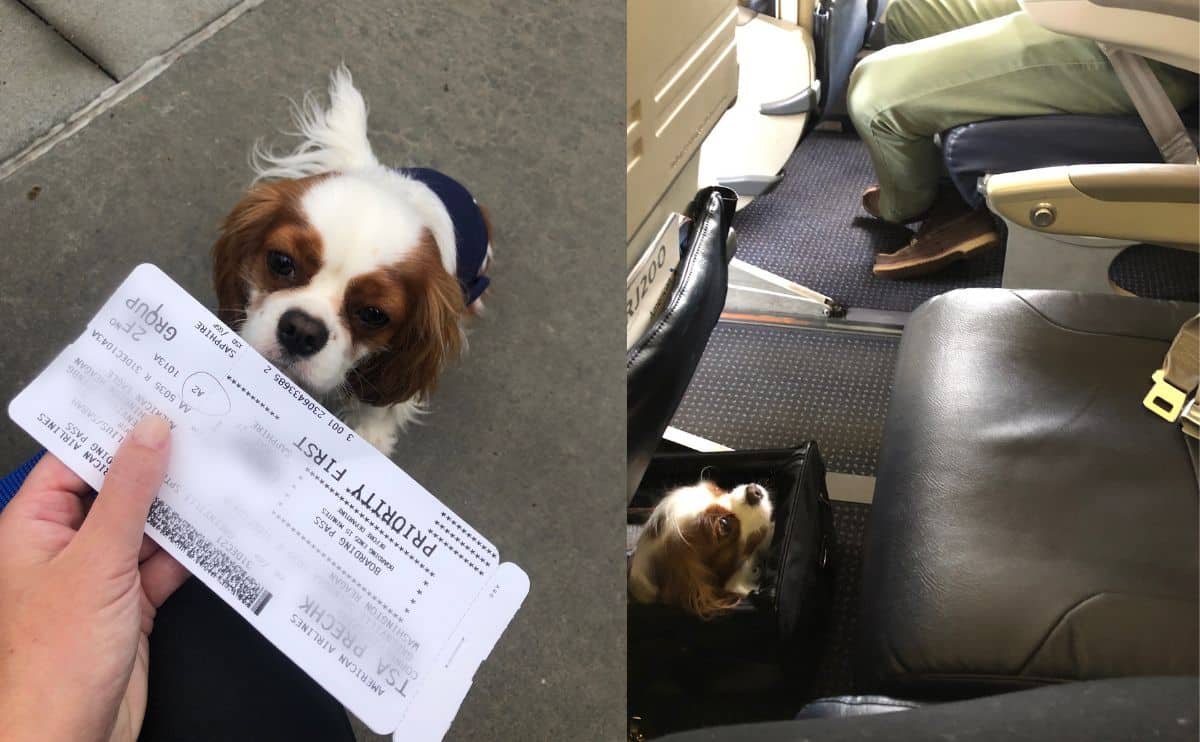
- What Makes Planes So Stressful – Unlike car travel, flying introduces pressure changes, strong odors, and long periods in tight quarters. If your dog is flying in cargo, they may be completely isolated, making it hard for them to stay calm.
- Preparing for Takeoff – Crate training is critical. Help your dog see the airline-approved crate as a secure and familiar place. Build up to longer durations inside it. Exercise your dog before heading to the airport to release extra energy. Consult your veterinarian if medication may be appropriate.
- Don’t Forget to Pack – Include absorbent bedding, an attached water and food dish, and a comfort item with your scent. Double-check that ID tags and microchip information are updated in case of emergencies.
- Rules and Regulations – Airlines often require a health certificate issued within 10 days of departure. Emotional support animals may no longer qualify for in-cabin travel, and rules can vary widely between carriers. Always confirm requirements well ahead of your trip.
Train and Bus Anxiety
Public transportation can introduce a new level of unpredictability. The unfamiliar environment, people, and sounds often trigger stress in dogs, especially those who are under-socialized.

- What to Watch For – Train and bus movement is different from car travel. It tends to be more abrupt and accompanied by loud noises and public announcements. Combined with crowds and new smells, this can overwhelm sensitive dogs.
- Smooth the Ride – Help your dog get comfortable in a soft-sided, well-ventilated carrier by practicing at home. Bring a quiet chew toy or bone for distraction. Use positive reinforcement to encourage calm behavior.
- Prepare Accordingly – Print a copy of the transit provider’s pet policy. Bring a muzzle if required, and ensure your dog has used the bathroom before boarding. Choose travel times with lower foot traffic whenever possible.
- Know the Rules – Amtrak allows small dogs under specific conditions. However, most buses, including Greyhound, only allow service animals. Local commuter trains may have breed or size restrictions. Always confirm before your trip to avoid issues at boarding.
7 Simple Hacks to Calm Your Dog’s Travel Anxiety
Traveling with a dog who gets anxious is tough, but with the right preparation and mindset, it’s entirely possible to help your pup feel safer, calmer, and more in control of their surroundings. These tips are grounded in expert behavior guidance, real-world experience, and, most importantly, compassion for what your dog is going through.
Here’s how to reduce stress for both of you and make travel a more enjoyable experience.
1. Stick to a Familiar Routine
Dogs thrive on consistency. When you’re traveling, try to maintain your pet’s regular feeding, walking, and sleeping schedule as closely as possible. Bring familiar items like their usual food, bowls, and bed to reduce environmental stress. Even replicating your at-home grooming habits (like brushing before bed) can create a sense of normalcy in an unfamiliar place.
Pro Tip: Use a digital reminder or checklist to keep your dog’s day predictable, even when you’re on the move.
2. Plan Your Travel Strategy Around Your Dog’s Needs
If your dog becomes highly anxious during travel, consider whether they really need to join you. In some cases, staying home with a trusted pet sitter or boarding with a professional might be less stressful. However, if they must come along, start prepping early. Gradually build up to longer car rides or short stays away from home to desensitize your dog to travel triggers.
Helpful Tip: If traveling without your dog, introduce the sitter or boarding facility a few days beforehand so it feels less abrupt. If you have never left your dog in a boarding or sitter situation, consider a trial run overnight before the trip.
3. Create a Calm, Safe Space Wherever You Stay
Hotel rooms, Airbnbs, and even friends’ homes can feel chaotic to dogs. Before bringing your pup inside, scan the space for anything they could chew, knock over, or get hurt on. Put away tempting decorations, food scraps, or trash. Set up a “comfort corner” with their bed, toys, and crate so they have a place to retreat when things feel overwhelming.
Watch Out For: Potential hazards like wires, houseplants, or open balconies that your dog might explore out of stress or curiosity.
Pro Tip: Always call ahead to confirm the specific hotel’s pet policy, including fees, weight or breed restrictions, and amenities. Policies can vary by location—even within the same chain.
Pet-Friendly Hotel Tips
Looking for dog-friendly accommodations? Some of the best-rated hotel chains for traveling with pets include Kimpton Hotels, La Quinta, Red Roof Inn, and several Marriott brands like Residence Inn and Element. Many of these locations even offer dog beds, treats, and welcome kits at check-in. You can learn more and see our personal experience with dog-friendly hotels here.
4. Manage Social Interactions Thoughtfully
Travel often comes with new people and environments, but overstimulation can quickly escalate anxiety in sensitive dogs. Limit introductions to new humans or animals, and avoid large gatherings or chaotic settings unless your dog is well-socialized and comfortable. If guests do visit, ask them to give your dog space until they approach willingly.
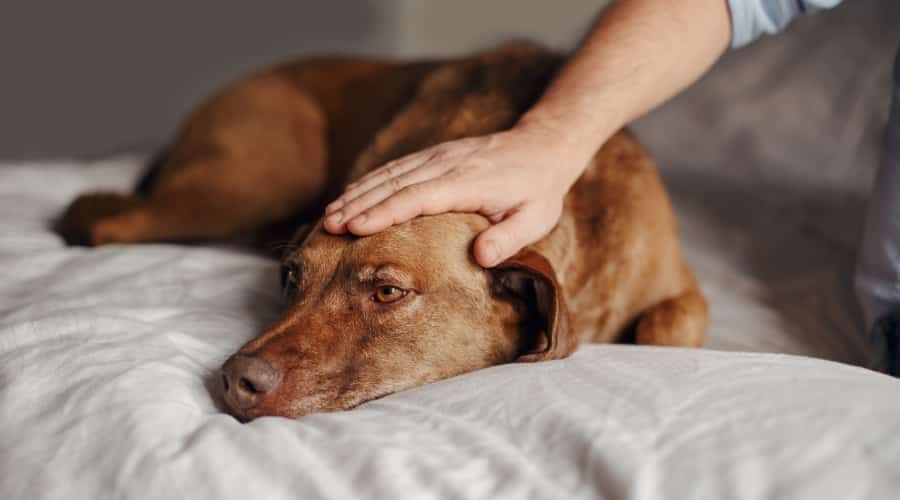
Pro Tip: Let your dog observe from a safe distance and use treats to reinforce positive interactions.
5. Avoid Table Scraps and Keep Diet Consistent
A sudden change in food can cause digestive upset and increased stress. Travel makes it tempting to spoil your dog or let them “sample” new snacks—but resist the urge. Stick to their normal food and treat routine, and avoid scraps from the dinner table that may be rich, spicy, or unsafe.
Good to Know: Certain common vacation foods like grapes, onions, and bones can be toxic to dogs. Always bring your own treats or kibble.
6. Explore the Area Before Letting Your Dog Roam
New places can hide unfamiliar dangers—sharp objects, toxic plants, or even wildlife. Take time to walk around your rental, campsite, or rest stop before letting your dog explore off-leash. Look for anything they could get into or eat, and always supervise their outdoor time closely.
Safety Reminder: In unfamiliar terrain, use a secure leash and harness to prevent your dog from bolting or encountering animals like snakes or coyotes.
7. Use Exercise and Crate Training to Ease Stress
Physical activity is one of the best ways to naturally reduce anxiety. A long walk before hitting the road or checking into your accommodations can help burn off nervous energy and promote calm. Bringing along a crate can also offer your dog a “safe zone,” giving them a retreat when they feel overwhelmed.
Crate Comfort Tip: Line the crate with a familiar blanket and toss in a favorite toy. If crate-trained properly, most dogs find it soothing—not confining.
Bonus Tip: Consider Vet-Approved Calming Aids
If your dog has severe anxiety, talk to your vet before your trip. They may recommend medication for travel-related stress or motion sickness. Over-the-counter options like calming CBD or melatonin chews, CBD oil, or pheromone sprays can also help, but always confirm dosages and safety with a professional first.
Learn More: Benefits of CBD for Dogs – including dosage, safety, and trusted brands.
Crate Training for Calm Travel: A Quick Guide
For many dogs, a crate can serve as a safe haven during travel. When introduced properly, it becomes a familiar, comforting space that helps reduce anxiety in new or unpredictable environments. Here’s how to make crate training a positive experience:
- Start at Home: Introduce the crate in a quiet, familiar space. Leave the door open and let your dog explore it on their own.
- Make It Inviting: Add soft bedding, a favorite toy, and something with your scent, like a T-shirt.
- Use Positive Reinforcement: Reward your dog with treats and praise every time they enter the crate voluntarily.
- Practice Short Sessions: Begin with just a few minutes at a time and gradually increase the duration.
- Associate It with Calm: Avoid using the crate for punishment. Instead, make it a place where your dog goes to relax.
- Crate in the Car: Once your dog is comfortable at home, take short car rides with them crated to build confidence.
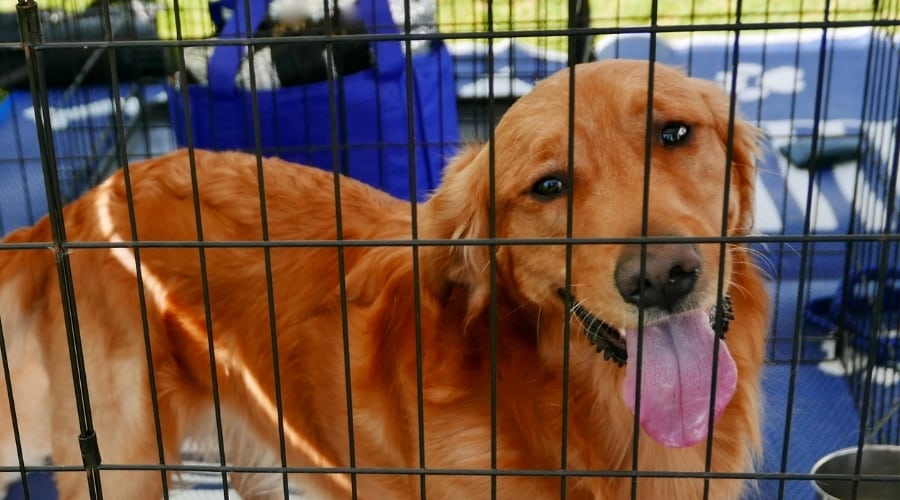
With time and consistency, the crate becomes more than just a travel tool—it becomes a reliable, anxiety-reducing space your dog can count on. The AKC notes that crate training helps dogs self-soothe during stressful situations, like travel, fireworks, and thunderstorms.
In-Transit Safety Tips: Carrier, Hydration, Breaks
Keeping your dog physically safe and comfortable during travel is just as important as reducing their anxiety. These tips will help ensure a smooth ride or flight for both of you:
- Use a Secure Carrier or Crate: It should be well-ventilated, large enough for your dog to stand and turn around, and crash-tested if possible (for car use).
- Take Frequent Breaks: On road trips, stop every 2–3 hours for potty breaks, short walks, and water. This prevents physical discomfort and helps break up the stress.
- Hydrate Before and During: Offer water regularly, especially in warm weather. Travel bowls or no-spill containers are great for on-the-go hydration.
- Never Leave Dogs Unattended in Vehicles: Even a few minutes in a parked car can be dangerous due to rapid temperature changes.
Bonus Tip: For longer flights, ask your airline about pet-specific accommodations and carry a travel certificate from your vet.
3 Natural Aids for Calmer Travel: CBD, Pheromones, and Thundershirts
If your dog experiences mild to moderate travel anxiety, natural calming aids can be a gentle and effective way to reduce stress without turning to prescription medications. While every dog responds differently, here are a few popular options many pet parents (and vets) recommend:
- CBD for Dogs: Cannabidiol (CBD) may help ease anxiety in dogs by supporting the endocannabinoid system. Many owners report improvements in calmness and relaxation during car rides or flights. Always choose products designed specifically for pets, start with a low dose, and consult your vet first. A recent study in the Journal of Animal Science found that daily CBD (4 mg/kg) significantly reduced stress indicators in dogs.
- Pheromone Diffusers and Collars: Products like Adaptil mimic the calming pheromones that mother dogs naturally release. Available as collars, sprays, or plug-in diffusers, they can help your dog feel more secure in unfamiliar settings.
- Thundershirt or Anxiety Wrap: A snug-fitting wrap like the Thundershirt applies gentle, consistent pressure to your dog’s torso—similar to swaddling a baby. This can reduce anxiety during car rides, thunderstorms, or flights. For best results, introduce the wrap before your trip so your dog associates it with calm, not change.
The Travel Anxiety Routine That Finally Helped Daisy
Back when we moved, Daisy’s travel anxiety wasn’t just inconvenient. It was heartbreaking. Her panic was so intense that she’d cry, bark, whimper, and even soil the car out of fear. I tried calming music, exercise before drives, and short practice trips. Nothing seemed to take the edge off.
What eventually made the biggest difference was a combination of tools, all recommended and approved by her vet. A low dose of Benadryl helped ease her physical symptoms like pacing and drooling. We paired that with a calming CBD oil formulated for dogs, which helped her relax without feeling sedated.
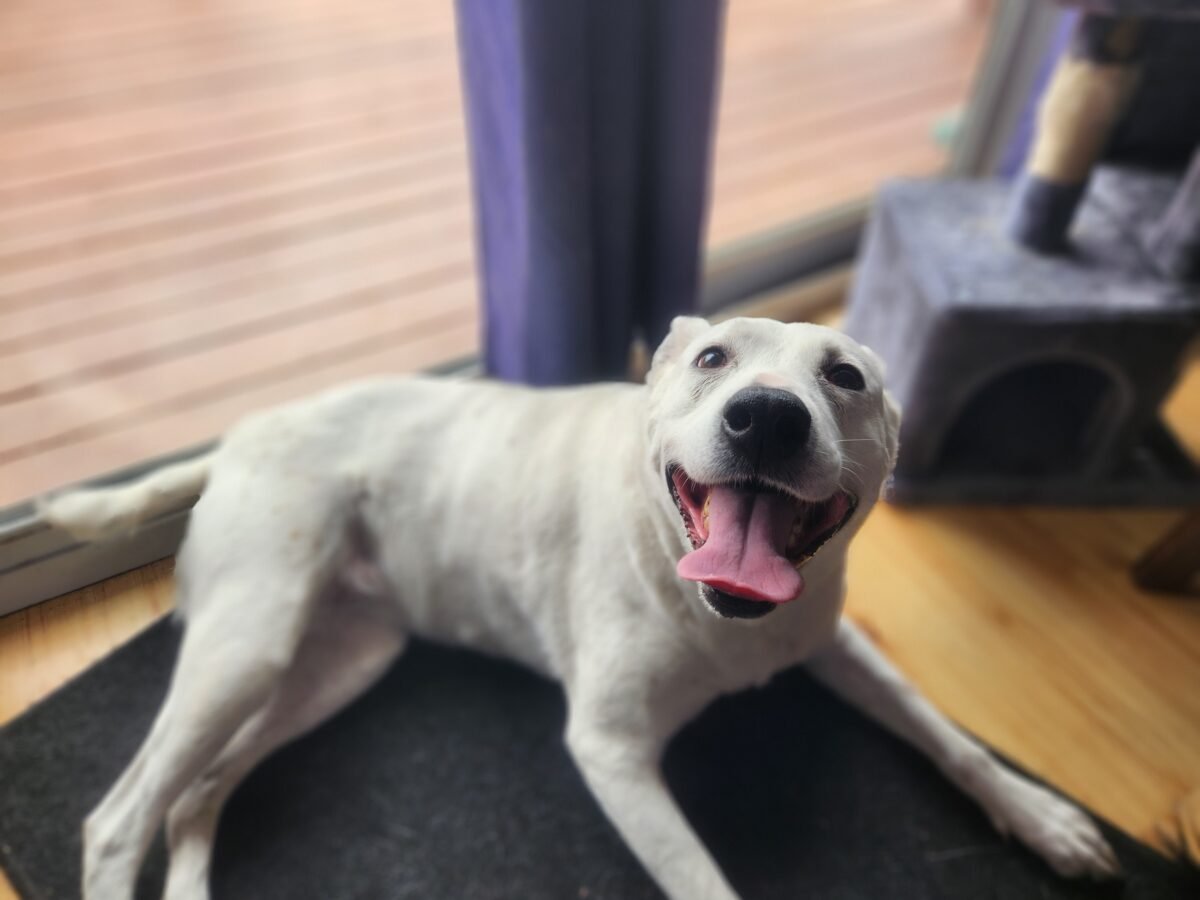
The final piece was a Thundershirt. This snug, pressure-based wrap gave Daisy a reassuring sense of security, especially during car rides. We introduced it gradually at home, so when it was time to travel, she already associated it with calm and comfort.
It wasn’t a perfect cure, but it was a breakthrough. For the first time, Daisy could sit still, rest a little during drives, and even settle in unfamiliar hotel rooms without spiraling. With patience and a consistent routine, she learned that travel didn’t have to mean panic.
The takeaway? Sometimes, the most effective approach involves layering a few supportive tools. With the right mix of medication, natural aids, and comforting gear, even the most anxious pups can find their calm.
Vet-Recommended Medications & Dosage Guidance
For dogs with more severe anxiety or motion sickness, your veterinarian may recommend prescription medications. These are typically short-term solutions for travel days only. Never give your dog medication without veterinary approval, as incorrect dosages can be dangerous.
- Acepromazine: A tranquilizer that reduces anxiety and causes sedation. Often used for dogs with travel phobia.
- Trazodone: Commonly prescribed for dogs with situational anxiety. Can promote calmness without heavy sedation.
- Gabapentin: Helps with anxiety and nerve pain. Often used in combination with other meds.
- Cerenia: FDA-approved for motion sickness in dogs. Prevents nausea and vomiting during car or air travel.
Dosage Tip: Start a trial run at home before your actual travel date to monitor side effects. Discuss timing and dosage with your vet based on your dog’s weight, age, and medical history.
4 Behavioral Desensitization Techniques
Desensitization helps your dog gradually adjust to travel-related triggers before the big day. It’s a slow and steady process but incredibly effective for long-term anxiety reduction.
- Start Small: Begin by exposing your dog to the car without going anywhere. Let them sit in it with the engine off, rewarding calm behavior.
- Gradually add Stimuli: Move to short trips around the block, then increase the distance and duration as your dog becomes more comfortable.
- Pair with Positive Reinforcement: Use treats, praise, or a favorite toy to reward your dog during and after each exposure session.
- Stay Consistent: Practice several times a week. Repetition and patience are key.
Training Tip: Keep sessions short and always end on a positive note. Avoid forcing your dog into the car or pushing too fast.
Recognizing the Signs of Travel Anxiety in Dogs
Not all anxiety shows up as obvious panic. Sometimes, signs are subtle—especially in the early stages. Spotting these behaviors early can prevent escalation and help you intervene before a full-blown meltdown.
Common signs of travel anxiety include:
- Vocalizations: Whining, barking, howling
- Restlessness: Pacing, circling, inability to settle
- Physical symptoms: Drooling, panting, shaking, yawning, lip licking
- Hiding or avoidance: Refusing to get in the car or cowering in a corner
- Destructive behavior: Scratching, chewing, digging at the crate or seat
- Bathroom accidents: Urinating or defecating due to fear
- Hypervigilance: Wide eyes, stiff body, overreacting to sounds or movement
Tip: Track your dog’s behaviors in different environments—at home, in the car, or at a hotel. Patterns can help you pinpoint what’s triggering their stress and where to focus support.
Pre-Trip Checklist: 10 Things to Pack for a Calm, Safe Journey
Before you hit the road (or take to the skies), be sure you have everything your dog needs to stay comfortable, safe, and calm.
Here’s a quick checklist to guide your prep:
- Regular food and treats (in sealed containers)
- Fresh water and no-spill travel bowl
- Medications and supplements (including motion sickness aids)
- Vet records and travel health certificate
- Crate or carrier with soft bedding
- Leash, harness, and ID tags
- Calming aids: CBD oil, Thundershirt, pheromone spray
- Toys or chews for distraction and comfort
- Waste bags and cleaning supplies
- Familiar items: blanket, shirt with your scent, favorite toy
When to Seek Professional Help for Travel Anxiety
If your dog’s anxiety is severe, persistent, or escalating—despite trying natural aids, crate training, or medication—it may be time to consult a professional.
Consider reaching out if:
- Your dog refuses to travel altogether
- They exhibit dangerous behaviors (bolting, aggression, self-harm)
- Anxiety continues long after you’ve reached your destination
- They aren’t responding to typical calming techniques
You might work with:
- Your veterinarian can rule out underlying health issues and prescribe medication
- A certified dog behaviorist who specializes in anxiety and behavior modification
- A veterinary behaviorist for complex or treatment-resistant cases
Getting help isn’t a failure—it’s a loving, responsible step toward helping your dog live with less fear and more confidence.
Travel Is Better When Your Dog Feels Their Best
Your dog doesn’t have to love every journey, but they can feel safe, supported, and calm along the way. By tuning into their needs, keeping their routine consistent, and using the right combination of calming tools and behavior strategies, you’re not just making travel easier. You’re strengthening the bond between you. Whether it’s a short road trip or a big move, showing up for your dog in these moments can make all the difference.
Want more support? We’ve put together practical, vet-backed tips to help you with everything from choosing calming aids to creating dog-friendly routines on the go. Explore our guides on CBD for dogs, calming supplements, crate training, anti-anxiety beds, and more to help your dog stay healthy, happy, and confident, no matter where life takes you.
Got Any Travel Tips of Your Own?
We’d love to hear what’s worked for you and your pup. Whether it’s a favorite calming product, a go-to hotel, or a clever trick for long rides, share your experience in the comments below and help other pet parents travel with confidence!


